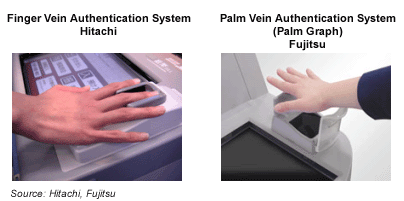Biometric ATMs in Japan: Fighting Fraud with Vein Pattern Authentication
Abstract
Japan's banking industry is placing its bets on biometrics as a solution to the growing problem of counterfeit ATM cards and ID theft. First introduced in October 2004, biometric bank cards have been announced by 15 financial institutions (two megabanks, five regional banks, and eight credit unions) as of December 2005. More than 50 other institutions have announced plans to introduce the cards over the next several years.
Recent years have seen financial institutions worldwide turn to biometric technology in order to deal with the pressing issue of security, usually in the internal, corporate, and high net worth sectors. The mass retail segment, however, has been slower than other segments to embrace biometrics. Barriers to adoption have included cost, a lack of application standards and interoperability, and customer resistance to adoption of the new technology.

Against this background, the Japanese banking industry's implementation of a new biometric technology based on vein patterns to authenticate ATM transactions is attracting attention. The Japanese banking industry, which since late 2003 has come under pressure to strengthen security in order to combat the growing problem of counterfeit bank cards and ID theft, has turned to vein pattern authentication technology as one solution. In October 2004, the Bank of Tokyo-Mitsubishi UFJ began to offer ATM cards that authenticate the customer by vein patterns in the palm of the hand. Other major banks in Japan have followed by announcing their own plans to adopt biometric bank cards utilizing either palm vein authentication or a rival technology based on vein patterns in the finger.
"Japanese banks' pioneering use of vein pattern authentication technology in the mass retail banking sector is a first," comments Junko Nose, author of Celent's new report, . "If these banks get significant consumer adoption of the new technology, it will be a valuable case study for banks around the world on how to successfully implement a biometric strategy in retail banking."
The report assesses the prospects for vein pattern authentication in the mass retail banking sector, which has historically been resistant to biometric technology. The report examines the security issues facing ATM systems at retail banks in recent years and presents an in-depth overview of vein pattern authentication and other biometric technologies offered by Japanese vendors. The report also features exclusive case studies detailing the adoption of vein pattern authentication technology at Japan's four largest banks, The Bank of Tokyo-Mitsubishi UFJ, Japan Post, Mizuho Bank, and Sumitomo Mitsui Banking Corporation (SMBC).
The 59-page report contains 8 figures and 10 tables. A table of contents is available here.

